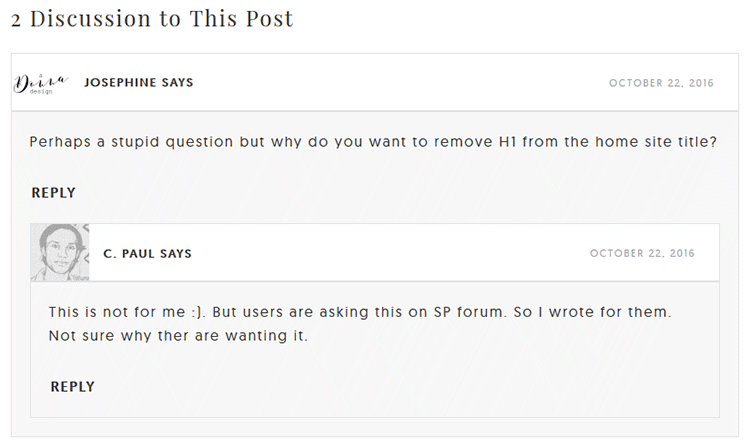If you’re using a theme based on the Genesis Framework (affiliate link), you’ll notice that your homepage site title is wrapped in an H1 heading (<h1>).
This not so good, and I’ll explain below why.
Fortunately, the site title in the Genesis Framework will be wrapped into a paragraph tag (<p>) on other pages and posts, so that’s good.
So, you only have to deal with the homepage situation.
Why isn’t it good to have your homepage site title as an H1
I usually tend to go straight to the point, but in the post where I’ve found the solution, a user was asking why would someone want to remove the H1 heading from the homepage site title in a Genesis Framework theme.

The comment is from this post.
The developer didn’t know the answer either, so I decided to provide the reasons here, in case someone will be wondering the same thing.
I’ve also left a comment there, but I don’t think the blog is active anymore.
I’ll start by telling you that the H1 heading is almost as important as your title (<title>) when it comes to on-page SEO.
Title (<title>) is different than the H1 tag (<h1>), but both are very important in describing the topics of your pages and posts.
So, keep this in mind as you read the reasons below.
Reason 1 – Headings shouldn’t be used for images
If you upload a logo, then you’ll have an image inside an H1 heading, which is not right.
H1 headings, as well as other headings, are made for text (titles), not images.
If a logo is wrapped around an H1 tag, then it’s a complete waste of an important heading tag.
Reason 2 – H1 headings should describe the main topic of a page or post
An H1 heading is basically your on-page title, and it should describe the main topic of the page or post for both users and search engines, so they can better understand what’s your page or post about.
When you create a page in WordPress, for example, and add a title to it, that will appear as an H1 – if the developers won’t mess it up and make the titles H4 or something.
Usually, when it comes to blog posts, the H1 heading is the same as the title.
When it comes to pages, you’ll notice that it usually differs, mainly for marketing purposes, but H1s should always be descriptive and contain a keyword.
Reason 3 – You’ll end up having two different H1 headings on the page
If you leave your site’s name as the site title, but then use another H1 heading as your homepage title (in case you don’t run a blog and show your latest posts on your homepage), you’ll end up with two H1s on one page, which is not the best SEO practice.
Since the H1 heading acts like your on-page title, as I mentioned above, you’ll end up having two titles, which might confuse search engines.
Example
Let’s say that you create a website for your BBQ bar, called “White Horse”, and you leave that as your site title.
But then, when you create a nice looking homepage, you add a separate H1 heading with a more descriptive text, like: “Best BBQ bar in Brooklyn, New York”.
The search engines can go: “Hmmm, is this site about a white horse or a BBQ bar?”.
Yes, I know, search engines are smart these days, and they can eventually figure things out, but this can still hold you back from having a better and more efficient on-page SEO!
The better you optimize your content, the better will search engines understand it! And if they understand it better, without any possible confusion, they will rank it better too!
Makes sense? Yep, it does!
You’ll see some people saying that it’s ok to have multiple H1 headings on a page, and then they’ll refer to an old Matt Cutts video. Just ignore them.
You go on and optimize your site as well as possible and apply the best practices!
I’m not saying that Matt Cutts doesn’t know what he’s talking about. It’s just that some people don’t exactly understand what he’s explaining there.
Note that on some other WordPress themes, the H1 site title won’t change on other pages or posts, as it does in the Genesis Framework, so you’ll end up with the same H1 heading on every page, plus other H1s added as your post or page titles.
Now, let’s get to the main topic of this tutorial! Finally!
Remove the H1 heading from the homepage site title in your Genesis Framework theme
The most straightforward code that I could find – since I’m not a developer by profession – is this one:
add_filter( 'genesis_pre_get_option_home_h1_on', '__return_true' );
I tried it and it works fine, apparently.
You’ll have to add it in the functions.php of your child theme, not in the Genesis Framework!
Here’s how to access your WordPress theme’s files.
The functions.php file should normally be found in /public_html/wp-content/themes/YOURTHEMENAME/functions.php or /public_html/YOURDOMAIN.COM/wp-content/themes/YOURTHEMENAME/functions.php if you’re using an add-on domain.

Editing functions.php file in cPanel
Open the file for editing, copy the above code, and paste it right at the bottom or before ?> (if it has any).
I recommend backing up the file or the entire website before doing this!

That’s it!
The homepage site title from your Genesis Framework theme should now be wrapped in a <p> tag, not an H1 heading.
That’s a wrap
Don’t forget to share the post to help out others!
You can quickly subscribe to my newsletter by using this link or the subscription form.
If you have any questions or thoughts, drop a comment or send a message via contact or Facebook page.
You can also hit the follow button on Twitter and subscribe to the YouTube channel.
If you want to start your own WordPress blog, or need a website for your business, ThemeSkills’ WordPress installation service is at your disposal! On-going WordPress support and maintenance are on the menu as well!




How to change when it not Genesis framework theme?
It depends from theme to theme. Every theme or framework requires a different code.
Can u help me to add a h1 tag to my homepage I don’t have one at all
If the title that you add on the page editor (using Gutenberg or Classic Editor) is not automatically turned into an H1 on the front-end, then you’ll need to contact the theme developers and ask them how to change that inside your theme’s code.
Otherwise, you can add an H1 heading manually using the editor or a page builder. It depends on what you’re using to create your homepage, and if it’s a static one or a posts page (blog page, basically).
It didn’t work. Does the extra H1 disappear instantly?
Actually it’s simple. You don’t need coding. You can go to Appearance ==> Customize ==> Theme SEO Settings ==> Homepage to change your site title so it is not an H1.